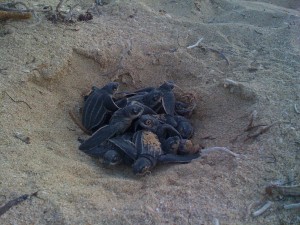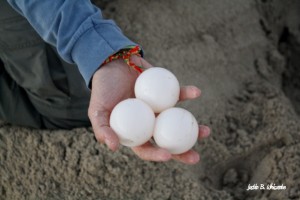
Excavating Leatherback Sea Turtle Nests

[The end of the turtle season was demanding on our schedules and other projects conspired to make this blog post fairly late.]
Night patrols at the Sandy Point National Wildlife Refuge concluded for the season on July 31, 2013. In final weeks of the 2013 leatherback season, biologists at Geographic Consulting shifted from night patrols to nest excavations and day patrols. This is far easier on our sleep schedule. However, day patrols are critical in helping us assess the status of the nesting population of leatherbacks (Dermochelys coriacea) at Sandy Point.
Nest excavations are among the most important activities that we conduct as part of the Sandy Point sea turtle monitoring project. Our goal in digging up nests that have already hatched is to determine how successful they were. We want to answer two primary questions: how many of the eggs laid actually developed into hatchlings, and how many of those hatchlings made it out of the nest and to the water. During the 2012 nesting season, the turtles laid a lot of nests but their hatch success was terrible, probably due to last summer’s drought. This year, we have fewer nests in the ground, but our hatch success seems to be fairly high. So at the end of the 2013 season, we might end up with the same amount of hatchling turtles swimming off of Sandy Point to hopefully return as nesting adults as we did last year even though there were fewer nests this year.
The actual process of excavating a turtle nest is not for anyone with a weak stomach. Even a nest with a high success rate has a number of eggs that did not develop completely or a hatchling or two that was not strong enough to make it out of the nest. It is the sad reality in the life of a sea turtle. As the contents of a hatched nest begin to decay, the smell is absolutely disgusting. Although we all wear gloves while excavating, the smell seems to permeate into everything: our backpacks, our clothes, even our skin. Not a single one of us has any desire to have eggs with our breakfast during the weeks that we excavate nests. But the information is so crucial and so interesting that we all put up with the discomfort. After all, turtle work can’t all be glamorous, right?




Comments, Questions? Contact Us.